Brass is one of the more popular metal alloys on the market today, as evidenced by the high number of brass sales over the years. Stripping it down to its most basic chemistry, brass consists of copper and zinc, both of which exist in a variety of ratios in relation to each other.
There are more than 60 known types of brass which can all be used in a wide range of applications. However, its very chemistry makes it susceptible to dezincification corrosion.
What is dezincification corrosion?
It is a type of selective corrosion wherein the zinc in the brass composition is specifically targeted, which causes it to leach and de-alloy from its partner, copper. This makes it difficult to use brass in applications that will bring it in direct contact with either high water temperatures, saltwater, or soft water.
For these applications, the specialty alloy called naval brass is used.
What is naval brass?
It is a type of beta brass that includes approximately 1% tin in its formulation to help combat the dezincification process. Since it’s a specialty brass, its range of application is pretty narrow. Nonetheless, its corrosion-resistant property makes it invaluable in marine repair applications. It can also be used in applications where the brass is inadvertently subjected to sea spray.
Can naval brass be welded?
Due to its rather high zinc content (around 39%) in respect to copper (around 60%), naval brass is rather difficult to weld and requires extra precaution in handling because it tends to release toxic, copper, zinc fumes. Hence, it’s never recommended to use manual metal arc welding processes when handling naval brass.
Instead, gas-shielded arc processes, such as MIG and TIG, are to be used. The gas used depends on the thickness of the naval brass to be welded. For less than 3mm, argon is recommended, while the thicker naval brass sections use a 75:25 mixture of helium and argon gas.
If you are interested in knowing more about naval brass and whether it is the correct brass to use for your intended applications, do not hesitate to contact a reputable metal supplier or a brass distributor to make the necessary inquiries.
Sources:
Brass Types, thebalance.com
Naval Brass, Uninhibited UNS-C46400, australwright.com


